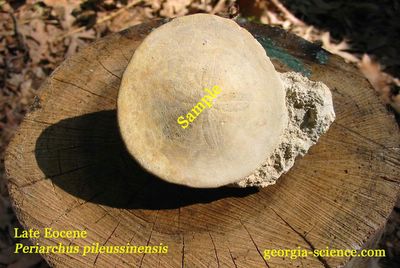Wednesday, April 30, 2008
Another Photo Sample of What's in Store
 The photo CD is still "under construction".
The photo CD is still "under construction".Other places to find more info:
georgia-science.com Website I
georgia-science.com Website II
(Will decide on the "winner" later), when the photo CD is ready for marketing.

Saturday, December 03, 2005
Fossil Echinoid ("Sand Dollar")

This Late Eocene echinoid is from the Tivola Limestone of Houston County, Georgia, near the community of Clinchfield. Similar ones are found in the Ocala Limestone of Florida and related limestone units.
The Eocene Epoch was a time of global warmth and great biodiversity, especially among echinoids (sand dollars, sea urchins, heart urchins). The Middle and Late Eocene of the Coastal Plain of Mississippi, Florida, Alabama, Georgia, North Carolina, and South Carolina have produced a rich diversity of echinoid genera and species.
These are among my favorite types of fossils. There are three other species of this sand dollar found in Georgia, one older, the other two younger. This genus became extinct at the end of the Eocene Epoch, approximately 37 million years ago.
Here are some links for the Periarchus genus: Periarchus pileussinensis, and Periarchus lyelli.
Here is a slide series concerning the Sandersville Limestone, where the echinoid Periarchus quinquefarius is found.
Here is some more Tertiary echinoid info.
As This Blog Evolves...
In addition to photos, there will be occasional bits about what to see while traveling. A little bit of internet preparation before a family vacation may pay off greatly with an improved understanding of what you are seeing, whether it be the Grand Canyon or the road-side view of lava flows, or perhaps even a listing of local rock shops.
All of these may help engender an interest in science in a child and it may help keep them occupied as you travel.
All of these may help engender an interest in science in a child and it may help keep them occupied as you travel.
Bracken Fern

Bracken Ferns, unlike some other ferns, prefer the well-drained soils of upland areas. This particular fern was on top of Chunky Gal Mountain, North Carolina.
Mammatus Clouds

Mammatus Clouds usually occur on the "underside" of supercells. This particular photo was taken while we were in Shattuck, OK for my in-laws' 50th Wedding Anniversary. If I recall, there were also tornados in the region that day.
Albuquerque Volcanoes

The Albuquerque Volcanoes are three cinder cones that lie west of Albuquerque, New Mexico and North of Interstate Highway 40. The are all geologically young, as young as 140,000 years before present, according to this website. They are primarily cinders (or scoria) with some spatter and flows around the vent area. These volcanoes and the underlying, older basalt flows are the result of fissure eruptions.
From downtown Albuquerque, which lies in the Rio Grande Valley, these volcanoes form part of the western skyline.
Monday, November 28, 2005
georgia-science.com - What it is.
It is a concept that has been "cooking" for about 3 1/2 years, since I got a digital camera. When funding is available, I plan to market CDs with scientific images for educational uses. Images will include such things as plants, clouds, trees, geological subjects,...
Other items may include used science books, and fossil, rock, and mineral specimens.
Some of the digital images hopefully available will be previewed on this site.
So check back every few days to see "what's new".
Other items may include used science books, and fossil, rock, and mineral specimens.
Some of the digital images hopefully available will be previewed on this site.
So check back every few days to see "what's new".



